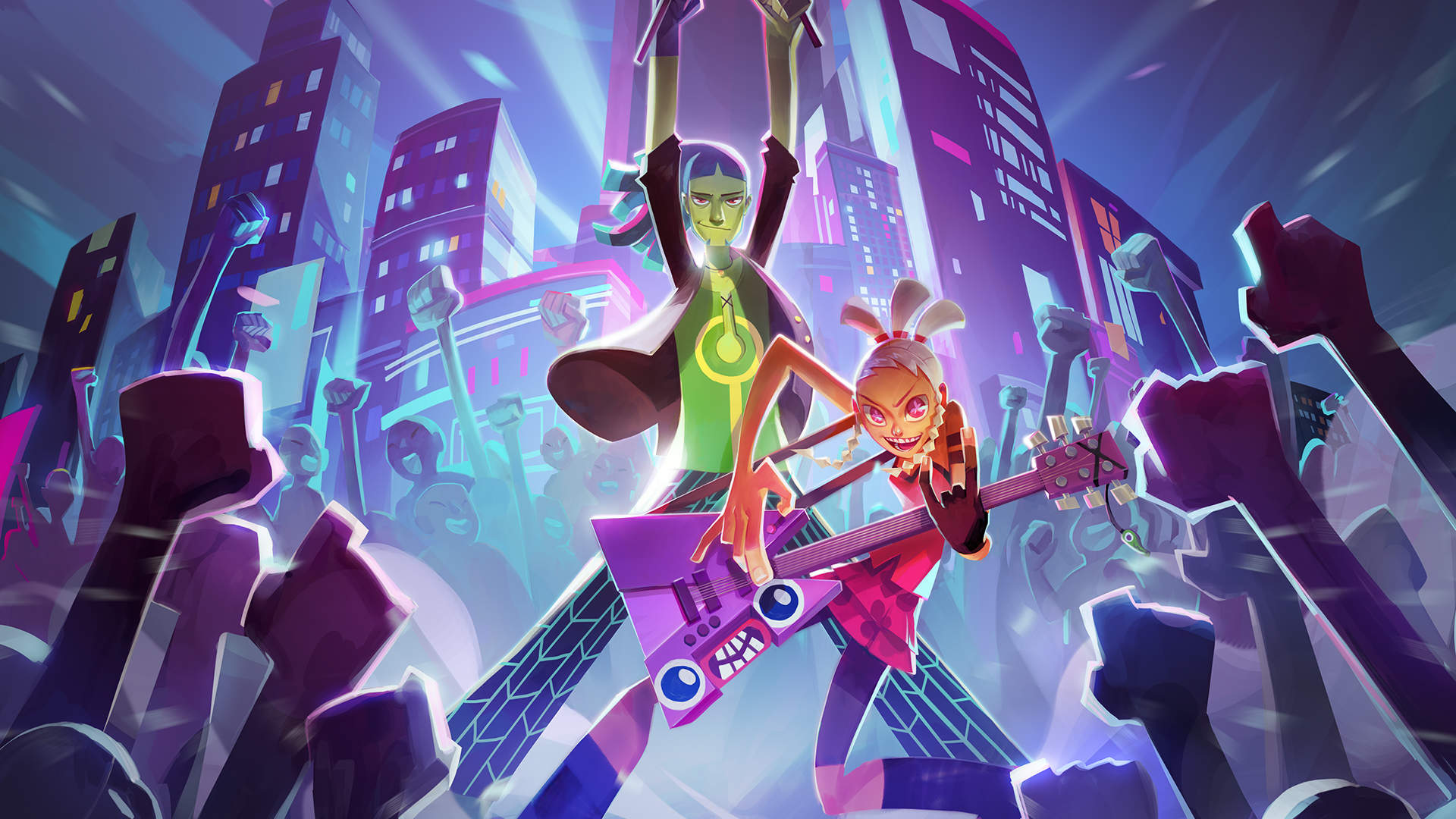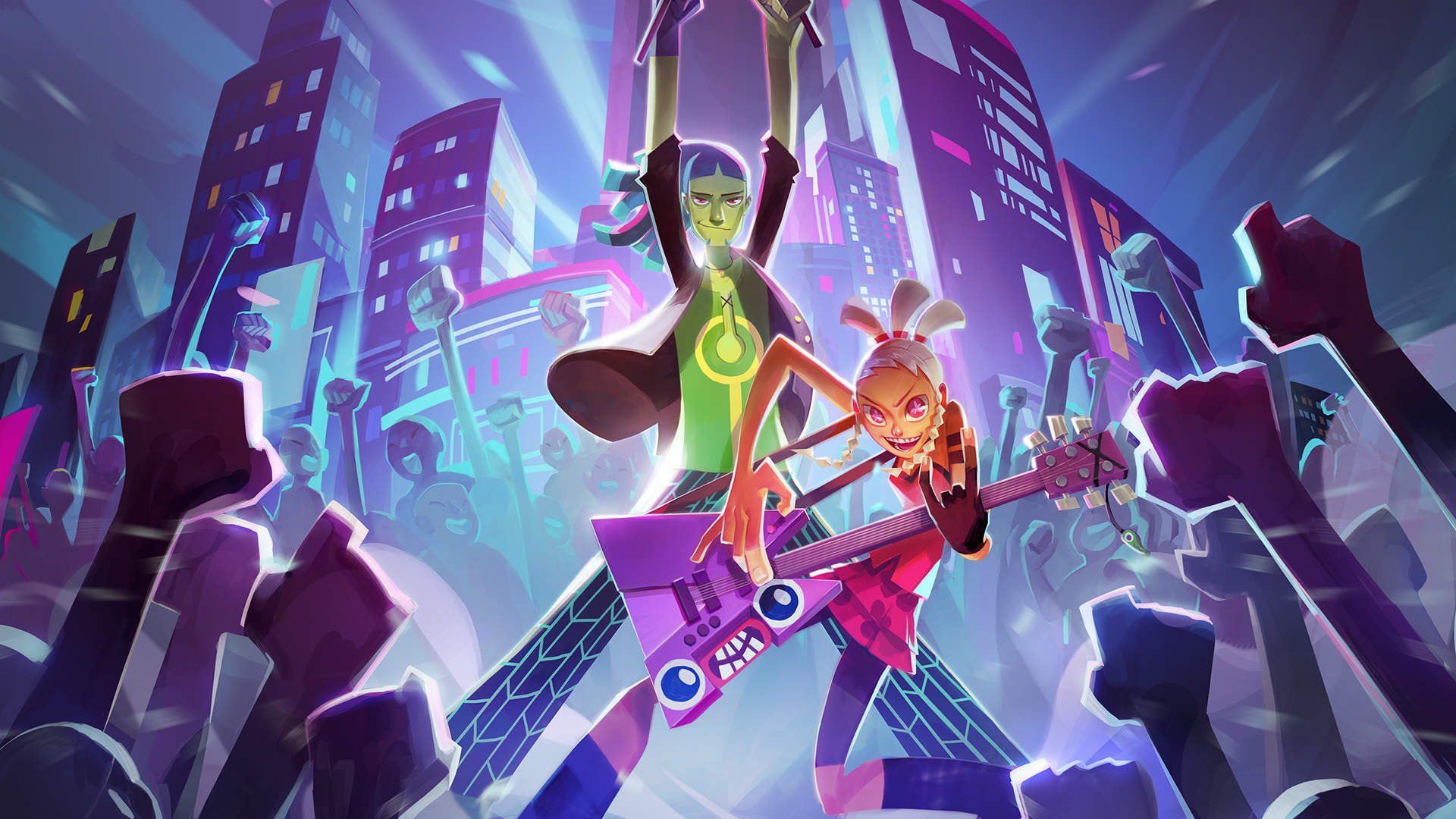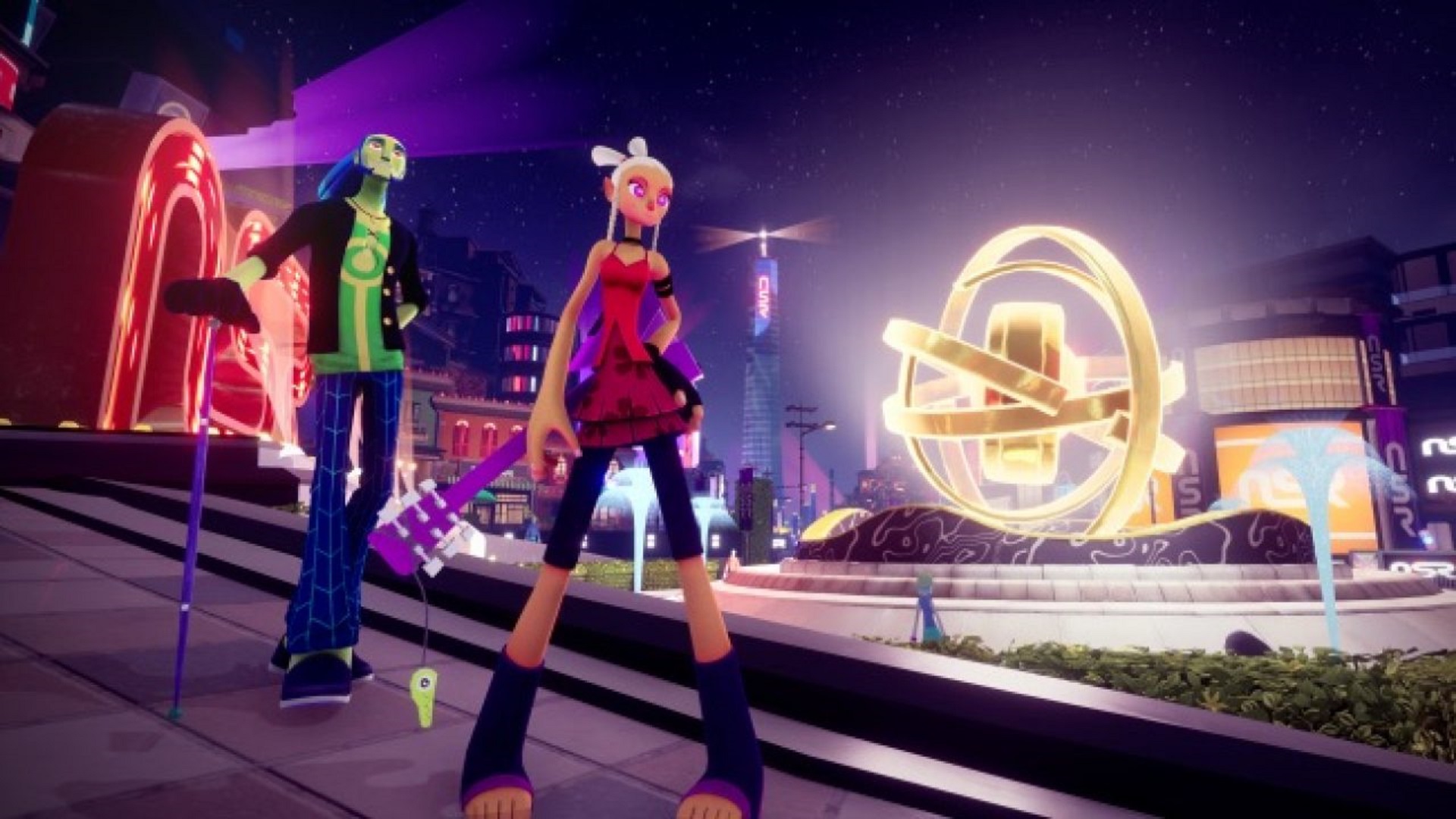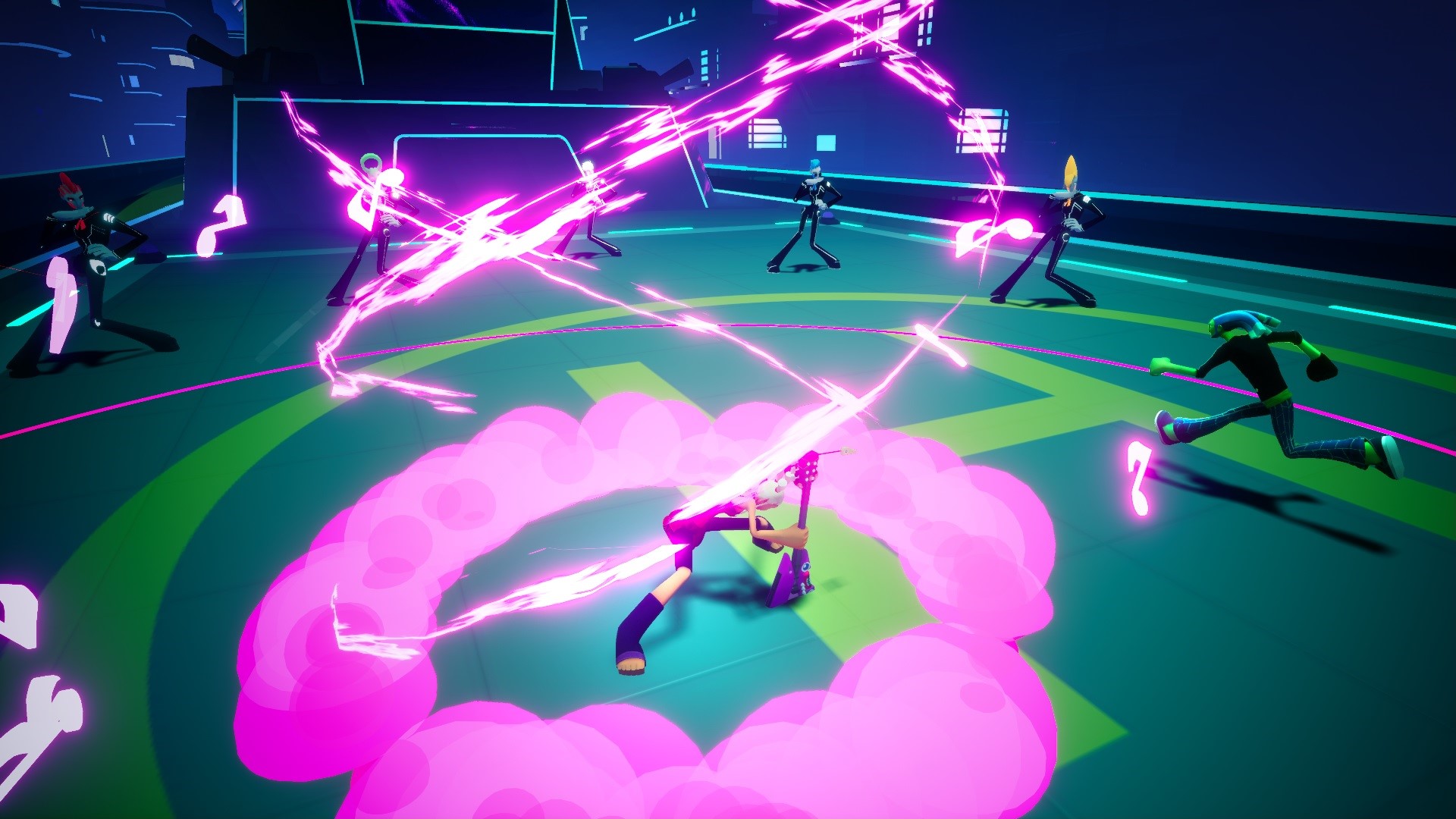
No Straight Roads’ devotion to its central musical premise makes it an immediately interesting prospect, and the more we’ve learned about it, the more curious about it we’ve become. From its rhythm-infused action gameplay to the variation its promising in the musical styles it features, from its zany, cartoony art style to its fascinating setting of the world’s musical capital ruled by an authoritarian EDM empire, there’s a lot to point at in this game for things that seem to be so different from what we usually see in the industry. Execution is just as important as ideas, of course, and that’s what will ultimately make or break this game, and to that end, to learn more about that and a little bit more about the philosophies behind the game’s ideas, we recently reached out to its developers with some of our questions about the game. You can read our conversation with No Straight Roads game director Wan Hazmer below.
"I view music as an interactive toy that comes with a set of rules utilizing rhythm and tempo that would play in harmony with user action."
How did the idea of creating a game where music is such an important part of the premise and the gameplay come up?
Me and my cousin Daim Dziauddin (co-founder of Metronomik) have always been passionate about music, albeit in different ways. I view music as an interactive toy that comes with a set of rules utilizing rhythm and tempo that would play in harmony with user action, while Daim views music as an entertainment form that has inspired many forms of art and brought people of all walks of life together.
I’ve always been an avid rhythm gamer since 1997, starting with Beatmania. Daim and I lived in Japan for 10 years and during that time, we’d play a ton of rhythm games at the Ikebukuro game arcades.
I have always thought that there must be a way to include music rules in game design without turning it into a rhythm game. A game that could provide rewards to the user who, be it intentionally or by pure instinct, understood the rules of rhythm, stanzas and tempo rather than rewarding them for having good “rhythm gamer” reflexes. It then dawned upon me that anyone could sing the tune of a chorus and tap to the beat after listening to a song once, and then be able to count 1-2-3-4-(chorus) after listening to it twice. This natural-born instinct for music in everyone became the core idea behind No Straight Roads, where enemies attack via a set pattern depending on the current position of the music. If users fully understand the relationship between the music and the gameplay, they will have a bigger advantage in combat.
After many discussions with Daim in Ikebukuro, we decided to make No Straight Roads an action-adventure game. That way, the game would trigger a mix of “action gaming” skills and natural rhythm sense in the user rather than forcing them to unleash their pure “rhythm gamer” skills.
We have always been fans of story-based games of the 90s and 2000s that did not take themselves seriously – point-and-click adventure games such as Monkey Island and Day of the Tentacle to story-centric rhythm games including Space Channel 5, Gitaroo Man and Cool Cool Toon. I thought that having a premise of a small fry fighting a big empire would be easy to understand, hence the age-old story of music genre battles came into the picture. Rock versus EDM was a surface-level concept, so Daim brought his unique perspective of musicians and music culture into the mix to add an intense level of depth into No Straight Roads world. He is deeply passionate about storytelling in entertainment. Rather than settling for a “heroes are good, villains are bad” setting, he made sure that every character and environment came with a deep thought of reasoning that ties with what music means to an individual. Every color and every shape in the action stages tell the story of the respective artist, and what you do to them will change the environment as well.
All in all, the core concept of No Straight Roads is “Music can change the world,” in more ways than one. To us, No Straight Roads is a love letter to everything music: songs, musicians, culture, etc.
Can you give us a little bit of information on Vinyl City, what players can expect from this setting, and how big of a part it plays in the whole experience?
Vinyl City is a city hub that the players can explore at their own leisure in-between levels. Here you can meet other characters, discover the city’s history, and interact with some of the props that are littered throughout. We wanted the city to be more of a break for the players who might want to enjoy a slower pace after a hectic boss fight and learn more about the world of NSR.
Vinyl City represents the personality of the empire and its people. Music is the main source of energy in the world of No Straight Roads but the empire, aptly named No Straight Roads, has been doing a poor job providing power to the city. Players can proactively help citizens and affect the city by powering up certain devices scattered throughout the game. This type of action will result in turning NPCs into fans and reward you with power ups for your skill tree. The city and its citizens will also act in response to your actions against the empire – that is something you could look forward to in the final game!
"When designing the gameplay behind Mayday and Zuke, we wanted to see them as musicians first, and game characters second. We put our focus on their instruments: the guitar and drumsticks."
The two main playable characters, Mayday and Zuke, having different musical abilities that they harness in different ways during combat is an interesting approach. Can you talk a bit about that and how it manifests as gameplay mechanics?
When designing the gameplay behind Mayday and Zuke, we wanted to see them as musicians first, and game characters second. We put our focus on their instruments: the guitar and drumsticks. We looked at real world musical playstyles and tried to replicate some of those techniques in our game. Drum hits are usually fast, so we assigned the rapid-hits playstyle to Zuke. With the guitar, there’s a lot of strumming, so we thought that could work well as a charging attack for Mayday.
Also, playing their instruments next to certain props will transform them into weapons (for Mayday) and utilities (for Zuke). In our minds, the guitar feels more analogous while drums feel more systematic. Hence, we translated those concepts into their transformations and their personalities as well.
How integrated is the music outside of combat, in things such as traversal or platforming?
We’ve thought of some of the common issues with music in games and implemented solutions to minimize them. Two that we’re particular proud of are:
For example, finding a balance between repetitiveness and abrupt change in the way the Sewer’s home base music is implemented. The music in this part of the game – and many others – will change to which rooms you visit, but in a way that doesn’t interrupt musical phrases.
Solving the age-old dilemma of games that want to be musically interesting and melodic without interfering with dialogue. To resolve this, we lowered the music’s intensity in the city dynamically during conversations. This would allow the player to hear character’s voices without music blaring in the background.
No Straight Roads will allow players to switch between rock and EDM – what does this mean in terms of the gameplay? How will the two differ from each other in terms of how players interact with the game?
In default play, boss music alters dramatically based on boss-specific conditions to convey the changes in the balance of power between the two sides, so it is more accurate to say that the genre of music is something dictated by player actions, rather than the other way around.
However, two game systems that do indeed have a more immediate correlation are the “Circle of Influence” feature that allows Mayday or Zuke to inject bursts of rock overdrive into whatever is playing at the moment. This also yields immediate gameplay benefits if used properly and the ability to replay bosses in bonus modes with the specific genres locked in. We do hope that people listen to the “Circle of Influence” more because we got some awesome guitar and drum solos there!
Clearly, in a game such as this one, music is a vital part of the experience. Can you talk us through the process that went with that and how much it defined and changed other parts of development?
For a game where music is as integrated as this one, the process of iteration was very lengthy. In broad terms, we established the concept for the boss and then did the basic version on the premise narratively and mechanically. After seeing some gameplay prototyping, changes were often made to the base version, and then the other two genres were made largely after the mechanical designs of the bosses came together. Making changes to the overall structure of the music at that point became much more difficult since all the music needed to work together.
Can you talk about progression mechanics in No Straight Roads and how extensive they will be?
Being a hybrid of action and music, we believe that there will be many types of gamers who will play our game: from the action-focused gamer who wants to have more skills in his arsenal, to the rhythm-focused gamer who just wants to parry everything in time with the music. As such, we imagine that players will tinker a lot with the skill tree, the stickers (passive buffs) and mods (special moves). You can get access to more of these as you hijack more concerts, gain more fans or explore more areas in the city. There are many facets of the progression system that will suit different styles of gameplay. You can choose to be more defensive, equip your characters with an insane amount of attack power or just gain more benefits that come with your parry.
"Being a hybrid of action and music, we believe that there will be many types of gamers who will play our game: from the action-focused gamer who wants to have more skills in his arsenal, to the rhythm-focused gamer who just wants to parry everything in time with the music."
What can players expect from the boss fights in terms of challenge and variety?
In the initial planning phase of No Straight Roads, we looked at the music industry as a whole. We handpicked motifs that we felt were fun to play with: child prodigies, boy bands, things that we find interesting to have in the game. From there, we tried to make sure that each boss had their own unique mechanics that fit with their themes and have a story to go with them as well. We’re excited to show them all to the players as we put a ton of love and care into each of the bosses!
Roughly how long will an average play through of No Straight Roads be?
If you’re looking to speed run the game without playing any of the extra modes, we think that it’ll be an average of four to five hours. However, the progression system is designed as such that you won’t get access to all layers of the skill tree if you choose to do so. We have “Hard Mode” and “Crazy Mode” for every boss stage for those who thirst for the extra challenge or for some extra fan power to activate skills deeper in the skill tree. Even if they don’t bring additional benefits to battle, hijacking harder modes and exploring the city more will unlock the EDM and rock versions of each boss stage, and you can choose to fight the boss in any of these tunes. For those of you who love our soundtrack, I don’t think it’s something you can simply ignore.
Will the game feature Xbox One X and PS4 Pro-specific enhancements? Is 4K/60 FPS on the cards?
The graphic quality will become better in those systems, but we don’t have huge enhancements like 4K and 60FPS at the moment. However, being action gamers ourselves, we made sure that it could run 60FPS on all systems regardless.
How is the game running on the original Xbox One and PS4, in terms of frame rate and resolution?
The graphic quality will be slightly lower, but it will still run at 60FPS at 1080p.
What are the docked and undocked resolution and frame rate of the Switch version?
The docked and undocked versions run at 720p and 480p respectively. Both run at 60FPS.
Given that next-gen consoles are right around the corner, have you given any thought to next-gen ports for the game?
We would love to do that! But it is not in the works at the moment. We would love to see the response that the current gen games receive first before exploring further options.
What are your thoughts on the PS5’s custom 3D audio engine Tempest? How much of a difference do you think tech like this will make to how immersive games can be?
A lot!!! Any progression on audio technology is always good. Having a 3D audio engine like Tempest simply means we can create more immersive environments, but more importantly, we can have gameplay designed around that technology for our future games. Exciting stuff, can’t wait to get our hands on it!
Since the reveal of the PS5 and Xbox Series X’s specs, a lot of comparisons have been made between the GPU speeds of the two consoles’ GPUs, with the PS5 at 10.28 TFLOPS and the Xbox Series X at 12 TFLOPS – but how much of an impact on development do you think that difference will have?
Just like next-gen announcements in the past, we were extremely excited about what things we could bring to the table when we have more power, even more so when we heard about the PS5 and Xbox Series X. At the same time, we would also try to predict what would be the next “limit.” These benefits and limits are usually tied to graphics, however we’re more interested on how to bring audio into this framework. We’ll think of more ways on how to integrate audio with gameplay, story and graphics, as we feel it is the most underutilized media element in games. What we can and cannot do, and more importantly, how we could entertain people with our audio in the next generation will be our biggest homework yet. Tempest is a great start, but we hope that our future works could influence next-gen device makers to put more emphasis on audio in games.
"If you’re looking to speed run the game without playing any of the extra modes, we think that it’ll be an average of four to five hours. However, the progression system is designed as such that you won’t get access to all layers of the skill tree if you choose to do so."
The PS5 features an incredibly fast SSD with 5.5GB/s raw bandwidth. This is faster than anything that is available out there. How can developers take advantage of this and what will it result to, and how does this compare to Series X’s 2.4GB/s raw bandwidth?
There is a difference in Zen 2 CPUs of both consoles. The Xbox series X features 8x Zen 2 Cores at 3.8GHz, whereas the PS5 features 8x Zen 2 Cores at 3.5GHz. Your thoughts on this difference?
There is a power difference between the two new consoles, there is no doubt about that. But do you think that power advantage of Xbox Series X will matter because of Microsoft’s cross gen policy?
We will answer the above three questions with one response. We’re sure the technology of both systems has its pros and cons, but what we’re looking forward to most is what these consoles bring to the user experience in the end, not only in terms of the games themselves but also the services that are attached to these games. Sure, we can make fully seamless games with a faster SSD and richer graphics with a better core processor, and to be honest we’re very excited to develop for both, but at the end of the day, it’s the end user-experience that matters. We want to see how these systems would integrate with the lifestyle and interests of the user outside of the game. In the field of music, it’s important for us to not only see the audio tech but also how these systems utilize the metaverse of cultures in its ecosystem, how well these systems understand the user, how it integrates with music libraries, online communities, etc. Creating a crafted experience that would seamlessly touch upon the user’s area of relevance in certain points would be wonderful, in a next-gen sort of way.
Xbox Series X’s BCPack Texture Compression Technique is reportedly better than the PS5’s Kraken. What are your thoughts on this?
We will continue to make zany and cartoony games in the future, however it is exciting that they’re looking into compression techniques as well. The more we can care less about tech that bogs a game down, the better. Although we would imagine that this compression technique would be of greater interest to Triple-A super-realistic game developers.
Do you think the Xbox Series X will out-power most gaming PCs for years to come?
We’re not really “PC Master Race” people (since we don’t think that technology is everything to a game), but we believe that the technology revolution curve is amazing. We’re very sure that the PC will catch up really soon. Or maybe, the concept of PC itself will change? You never know with all the amazing advancements we have made in the past years.
How are you ensuring that your engines/framework/tools are up and running for PS5 and Xbox Series X?
We have only operated for two and a half years since December 2017 and have been putting full focus on No Straight Roads. The systems that we made can be pretty rigid (only catered for No Straight Roads) so when we actually get to the point of creating next-gen games, we would focus more on making systems that can adapt to new game mechanics and new graphic and audio tech. Luckily, we have been using Unreal Engine the whole time and they’re on board for the next-gen devices, which will definitely make our lives a whole lot easier.







